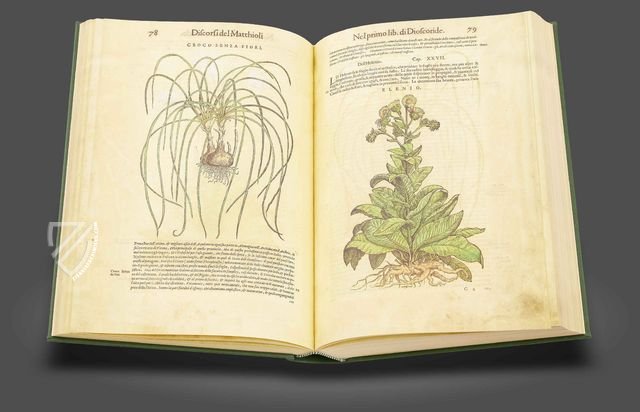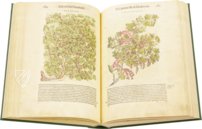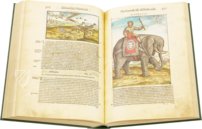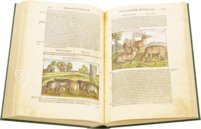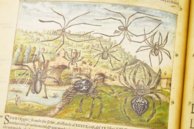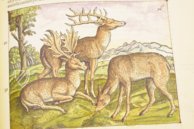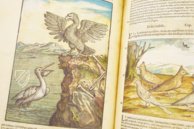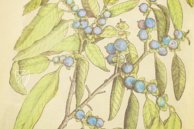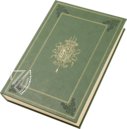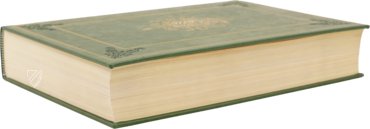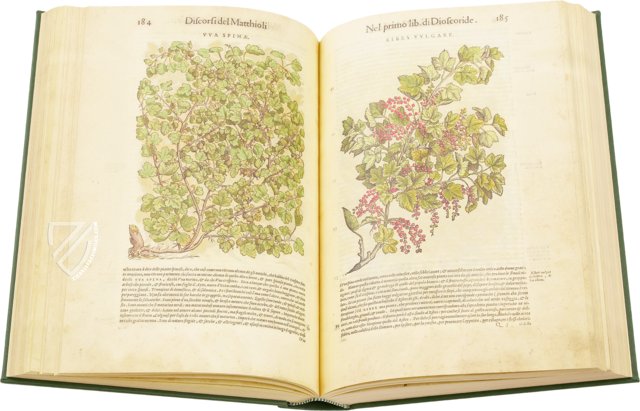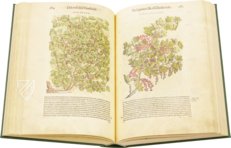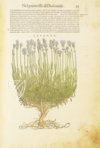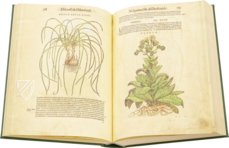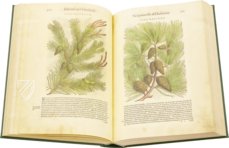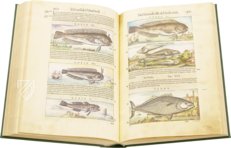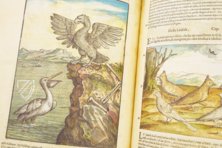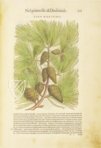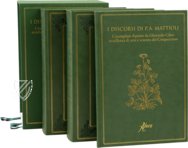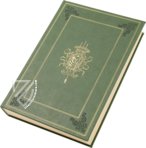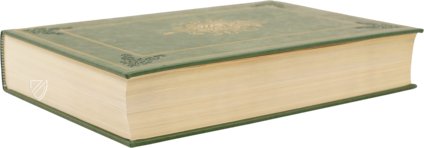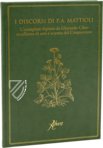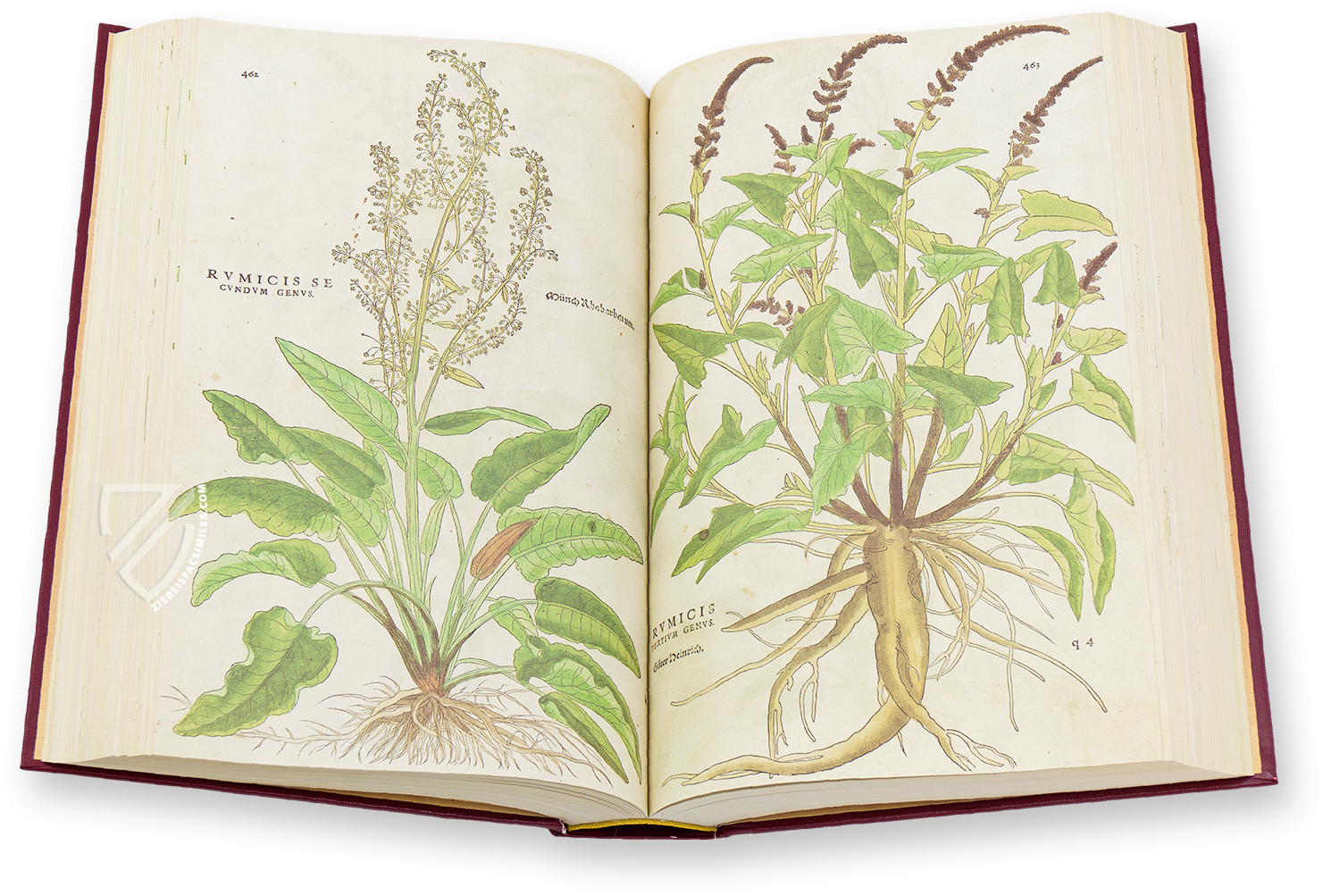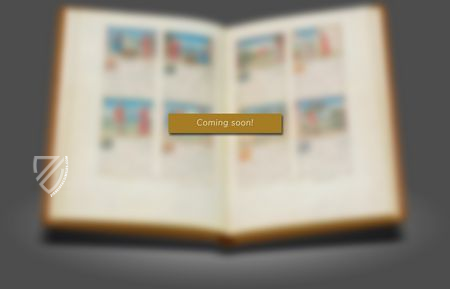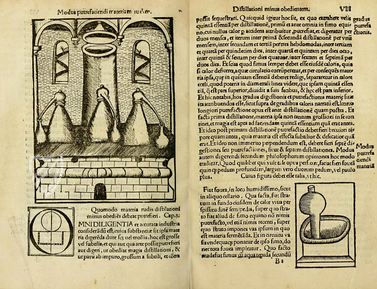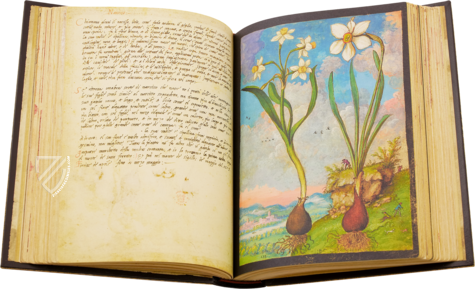Discorsi di P. A. Mattioli Illustrated by Gherardo Cibo
(1,000€ - 3,000€)
The Discorsi di P. A. Mattioli are a real milestone in the development of naturalistic botanical illustration in the early modern period. Pietro Andrea Mattioli's (1501-1577) text is based on the tradition of the famous ancient botanical-pharmaceutical work by Dioscorides and expands it with descriptions of 100 additional plant species. Mattioli's work is one of the first writings to take an interest in botany beyond its medical use. This aesthetically and art-historically particularly delightful copy of the pioneering work was embellished with breathtaking, subsequently colored copperplate engravings by the gifted artist Gherardo Cibo (1512-1600), whose artistry also greatly impressed the author himself. The work was printed in 1568 by the Venetian publisher Vincenzo Valgrisi and is of great significance for both the history of art and science.
Discorsi di P. A. Mattioli Illustrated by Gherardo Cibo
A masterpiece of medical-botanical literature, enriched by the colors and miniatures of a great master: the Discourses by Pietro Andrea Mattioli in the famous large print version published by Valgrisi in Venice in 1568. The specimen, now residing at the Alessandrina Library in Rome, is renowned for the magnificent decorations by Gherardo Cibo, who, in addition to coloring the engraving, completed the backgrounds with evocative landscapes produced by his fertile imagination.
A Gorgeous Specimen of a Vital Scientific Text
Presented in a magnificent manner, this text is a document of the progress of scientific thought during the genesis of modern science. Mattioli’s work not only commented on the Materia Medica by Dioscorides, he also described 100 new plants, not all of which necessarily had medical applications, making it one of the first works that examined botany outside of medicine. The numerous copies of the original to have been produced, as well as the quality of this individual specimen, speak to its importance. This specimen united the work of a great botanist with a master painter, presumably at the behest of a high-ranking bibliophile and lover of gardening. Thus, it represents a significant specimen of Renaissance art and science simultaneously.
The Author’s Impression of the Artist
This is how Mattioli expressed himself concerning Cibo's art and, in particular, his botanical illustrations, in a letter dated 24 June 1565: "It really seems to me that they are so alive and natural, that one could not ask for anything better; and most importantly that one can perceive an elegance afforded to them by the decoration with pleasant village landscapes that cannot be felt in the presence of natural images alone. For this reason I tell you that even though I have received colored drawings of plants from many different places, there is such a difference between these and the former, as one can see between lead and silver or, even better, between lead and gold" (Siena Municipal Library, cod. miscell. D, vii, 2. c. 15 r.).
Codicology
- Alternative Titles
- Pietro Andrea Mattioli's Discorsi
Discourses by Pietro Andrea Mattioli
Discorsi di P. A. Mattioli illustiert von Gherardo Cibo - Size / Format
- 1,728 pages / 35.8 × 25.0 cm
- Origin
- Italy
- Date
- 1568
- Epochs
- Style
- Language
- Illustrations
- Large, sometimes almost full-page colored copperplate engravings for almost every lemma
- Content
- Discorsi
- Artist / School
- Gherardo Cibo (1512–1600) (illuminator)
Pietro Andrea Mattioli (1501–77) (author)
Valgrisi (printer)
Discorsi di P. A. Mattioli Illustrated by Gherardo Cibo
Shearing Sheep
This pleasant pastoral scene depicts a prosperous farmer in a red cap with a feather harvesting wool with the help of his wife, who wears a flowing orange dressed, and his dog, who lays on the ground watching. His buildings are enclosed by a wattle fence and the hills where he grazes his sheep can bee seen in the background. The other sheep wander about munching on grass awaiting their turn while a large ram with long horns seems to look out from the page at the beholder.
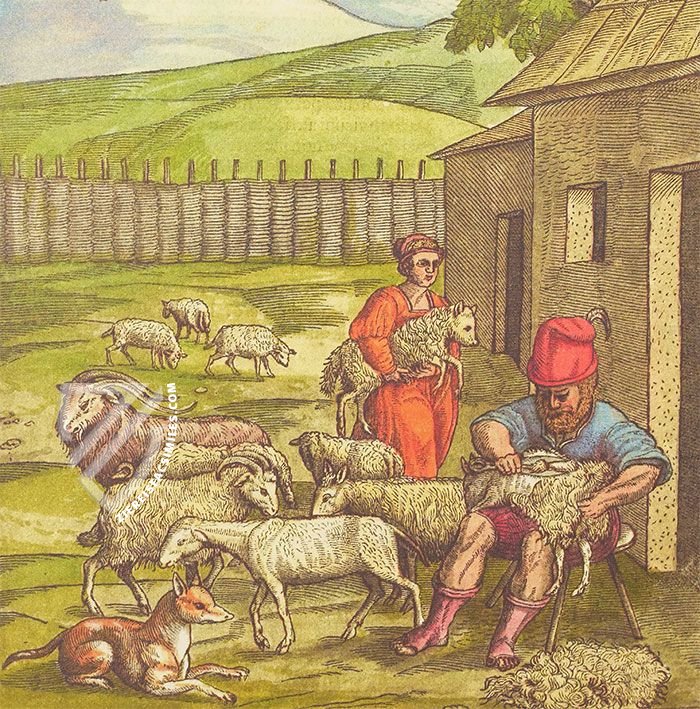
Discorsi di P. A. Mattioli Illustrated by Gherardo Cibo
Lavander
Popular as an ornamental plant, used as a culinary herb and in the making of essential oils, Lavandula is a genus of 47 different species of flowering plants that are actually part of the mint family. Commonly referred to as lavender, Lavandula angustifolia is the most widely cultivated variety and the distinct purple color of its flowers is also referred to as lavender, even if they are depicted as blue here.
Lavender has been used in traditional medicine and cosmetics since ancient Greece, soap in particular – its late Latin name lavandārius comes from the verb lavāre meaning “to wash”. As herbal medicine, lavender has been used to treat intestinal discomfort, restlessness, insomnia, anxiety, and may have other applications.
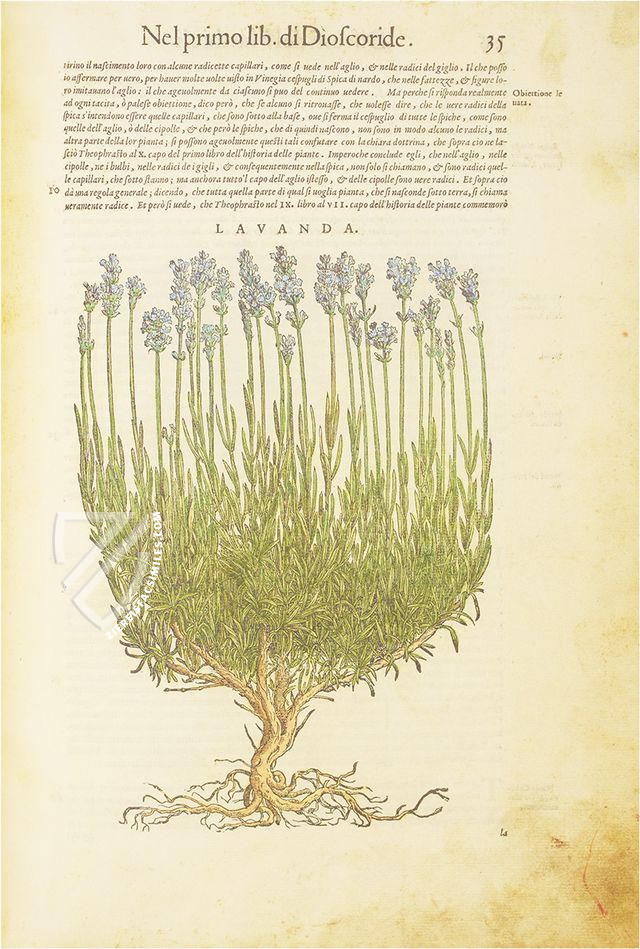
#1 I Discorsi di P.A. Mattioli
Language: Italian
(1,000€ - 3,000€)
- Treatises / Secular Books
- Apocalypses / Beatus
- Astronomy / Astrology
- Bestiaries
- Bibles / Gospels
- Chronicles / History / Law
- Geography / Maps
- Saints' Lives
- Islam / Oriental
- Judaism / Hebrew
- Single Leaf Collections
- Leonardo da Vinci
- Literature / Poetry
- Liturgical Manuscripts
- Medicine / Botany / Alchemy
- Music
- Mythology / Prophecies
- Psalters
- Other Religious Books
- Games / Hunting
- Private Devotion Books
- Other Genres
- Afghanistan
- Armenia
- Austria
- Belgium
- Colombia
- Croatia
- Cyprus
- Czech Republic
- Denmark
- Egypt
- Ethiopia
- France
- Germany
- Greece
- Hungary
- India
- Iran
- Iraq
- Israel
- Italy
- Japan
- Lebanon
- Luxembourg
- Mexico
- Morocco
- Netherlands
- Palestine
- Peru
- Poland
- Portugal
- Russia
- Serbia
- Spain
- Sri Lanka
- Sweden
- Switzerland
- Syria
- Turkey
- Ukraine
- United Kingdom
- United States
- Uzbekistan
- Aboca Museum
- Ajuntament de Valencia
- Akademie Verlag
- Akademische Druck- u. Verlagsanstalt (ADEVA)
- Aldo Ausilio Editore - Bottega d’Erasmo
- Alecto Historical Editions
- Alkuin Verlag
- Almqvist & Wiksell
- Amilcare Pizzi
- Andreas & Andreas Verlagsbuchhandlung
- Archa 90
- Archiv Verlag
- Archivi Edizioni
- Arnold Verlag
- ARS
- Ars Magna
- ArtCodex
- AyN Ediciones
- Azimuth Editions
- Badenia Verlag
- Bärenreiter-Verlag
- Belser Verlag
- Belser Verlag / WK Wertkontor
- Benziger Verlag
- Bernardinum Wydawnictwo
- BiblioGemma
- Biblioteca Apostolica Vaticana (Vaticanstadt, Vaticanstadt)
- Bibliotheca Palatina Faksimile Verlag
- Bibliotheca Rara
- Boydell & Brewer
- Bramante Edizioni
- Bredius Genootschap
- Brepols Publishers
- British Library
- C. Weckesser
- Caixa Catalunya
- Canesi
- CAPSA, Ars Scriptoria
- Caratzas Brothers, Publishers
- Carus Verlag
- Casamassima Libri
- Chavane Verlag
- Christian Brandstätter Verlag
- Circulo Cientifico
- Club Bibliófilo Versol
- Club du Livre
- CM Editores
- Collegium Graphicum
- Collezione Apocrifa Da Vinci
- Comissão Nacional para as Comemorações dos Descobrimentos Portugueses
- Coron Verlag
- Corvina
- CTHS
- D. S. Brewer
- Damon
- De Agostini/UTET
- De Nederlandsche Boekhandel
- De Schutter
- Deuschle & Stemmle
- Deutscher Verlag für Kunstwissenschaft
- DIAMM
- Droz
- E. Schreiber Graphische Kunstanstalten
- Ediciones Boreal
- Ediciones Grial
- Ediclube
- Edições Inapa
- Edilan
- Editalia
- Edition Deuschle
- Edition Georg Popp
- Edition Leipzig
- Edition Libri Illustri
- Editiones Reales Sitios S. L.
- Éditions de l'Oiseau Lyre
- Editions Medicina Rara
- Editorial Casariego
- Editorial Mintzoa
- Editrice Antenore
- Editrice Velar
- Edizioni Edison
- Egeria, S.L.
- Eikon Editores
- Electa
- Emery Walker Limited
- Enciclopèdia Catalana
- Eos-Verlag
- Ephesus Publishing
- Ernst Battenberg
- Eugrammia Press
- Extraordinary Editions
- Fackelverlag
- Facsimila Art & Edition
- Facsimile Editions Ltd.
- Facsimilia Art & Edition Ebert KG
- Faksimile Verlag
- Feuermann Verlag
- Folger Shakespeare Library
- Franco Cosimo Panini Editore
- Friedrich Wittig Verlag
- Fundación Hullera Vasco-Leonesa
- G. Braziller
- Gabriele Mazzotta Editore
- Gebr. Mann Verlag
- Gesellschaft für graphische Industrie
- Getty Research Institute
- Giovanni Domenico de Rossi
- Giunti Editore
- Graffiti
- Grafica European Center of Fine Arts
- Guido Pressler
- Guillermo Blazquez
- Gustav Kiepenheuer
- H. N. Abrams
- Harrassowitz
- Helikon
- Hendrickson Publishers
- Henning Oppermann
- Herder Verlag
- Hes & De Graaf Publishers
- Hoepli
- Holbein-Verlag
- Hortus Deliciarum
- Houghton Library
- Hugo Schmidt Verlag
- Idion Verlag
- Il Bulino, edizioni d'arte
- ILte
- Imago
- Insel Verlag
- Instituto Nacional de Antropología e Historia
- Istituto dell'Enciclopedia Italiana - Treccani
- Istituto Ellenico di Studi Bizantini e Postbizantini
- Istituto Geografico De Agostini
- Istituto Poligrafico e Zecca dello Stato
- Italarte Art Establishments
- J. Thorbecke
- Jan Thorbecke Verlag
- Johnson Reprint Corporation
- Josef Stocker
- Josef Stocker-Schmid
- Jugoslavija
- Karl W. Hiersemann
- Kasper Straube
- Kaydeda Ediciones
- Kindler Verlag / Coron Verlag
- Kodansha International Ltd.
- Konrad Kölbl Verlag
- Kurt Wolff Verlag
- La Liberia dello Stato
- La Linea Editrice
- La Meta Editore
- Lambert Schneider
- Landeskreditbank Baden-Württemberg
- Leo S. Olschki
- Les Incunables
- Library of Congress
- Libreria Musicale Italiana
- Lichtdruck
- Lito Immagine Editore
- Lumen Artis
- Lund Humphries
- M. Moleiro Editor
- Maison des Sciences de l'homme et de la société de Poitiers
- Manuscriptum
- Martinus Nijhoff
- Maruzen-Yushodo Co. Ltd.
- MASA
- McGraw-Hill
- Militos
- Millennium Liber
- Müller & Schindler
- Nahar and Steimatzky
- National Library of Wales
- Neri Pozza
- Nova Charta
- Oceanum Verlag
- Odeon
- Orbis Mediaevalis
- Orbis Pictus
- Österreichische Staatsdruckerei
- Oxford University Press
- Pageant Books
- Parzellers Buchverlag
- Patrimonio Ediciones
- Pattloch Verlag
- PIAF
- Pieper Verlag
- Plon-Nourrit et cie
- Prestel Verlag
- Princeton University Press
- Prisma Verlag
- Priuli & Verlucca, editori
- Pro Sport Verlag
- Propyläen Verlag
- Pytheas Books
- Quaternio Verlag Luzern
- Reales Sitios
- Recht-Verlag
- Reichert Verlag
- Reichsdruckerei
- Riehn & Reusch
- Roberto Vattori Editore
- Rosenkilde and Bagger
- Roxburghe Club
- Salerno Editrice
- Sarajevo Svjetlost
- Schöck ArtPrint Kft.
- Scolar Press
- Scrinium
- Scripta Maneant
- Scriptorium
- Siloé, arte y bibliofilia
- SISMEL - Edizioni del Galluzzo
- Sociedad Mexicana de Antropología
- Société des Bibliophiles & Iconophiles de Belgique
- Soncin Publishing
- Sorli Ediciones
- Stainer and Bell
- Studer
- Styria Verlag
- Sumptibus Pragopress
- Szegedi Tudomànyegyetem
- Taberna Libraria
- Tarshish Books
- Taschen
- Tempus Libri
- Testimonio Compañía Editorial
- Thames and Hudson
- The Clear Vue Publishing Partnership Limited
- The Facsimile Codex
- The Folio Society
- The Marquess of Normanby
- The Richard III and Yorkist History Trust
- Tip.Le.Co
- TouchArt
- TREC Publishing House
- TRI Publishing Co.
- Trident Editore
- Typis Regiae Officinae Polygraphicae
- Union Verlag Berlin
- Universidad de Granada
- University of California Press
- University of Chicago Press
- Urs Graf
- Vallecchi
- Van Wijnen
- VCH, Acta Humaniora
- VDI Verlag
- VEB Deutscher Verlag für Musik
- Verlag Anton Pustet / Andreas Verlag
- Verlag Bibliophile Drucke Josef Stocker
- Verlag der Münchner Drucke
- Verlag für Regionalgeschichte
- Verlag Styria
- Vicent Garcia Editores
- W. Turnowsky
- Waanders Printers
- Wiener Mechitharisten-Congregation (Wien, Österreich)
- Wissenschaftliche Buchgesellschaft
- Wydawnictwo Dolnoslaskie
- Xuntanza Editorial
- Zakład Narodowy
- Zollikofer AG

